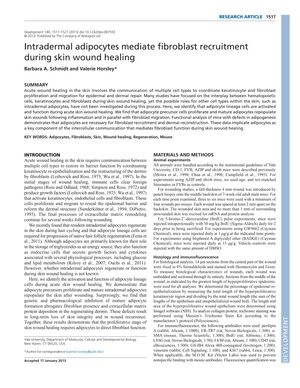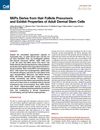Intradermal adipocytes mediate fibroblast recruitment during skin wound healing
April 2013
in “Development”

TLDR Fat cells help recruit healing cells and build skin structure during wound healing.
The document from April 1, 2013, presents research on the role of intradermal adipocytes in skin wound healing, focusing on their importance in fibroblast recruitment. The study utilized mice models, including AZIP mice lacking mature adipocytes and ob/ob diabetic mice with increased adipocytes, as well as pharmacological inhibition of adipogenesis in wild-type mice using PPARγ inhibitors. The findings indicate that adipocytes are necessary for fibroblast presence and extracellular matrix protein deposition in the wound bed, which are crucial for dermal reconstruction. The absence of adipocytes led to reduced fibroblast presence, collagen, and fibronectin production, resulting in impaired skin integrity and wound recurrence. The study involved a range of 3 to 6 mice per time point and a minimum of 4 wounds per mouse, with 10 wounds from 5 mice for immunostaining and 6 mice for each time point from two experiments for FACS staining. The research suggests that adipocytes may facilitate fibroblast production and migration during the healing process and that defects in adipocyte function can negatively impact wound healing, highlighting the potential for targeting adipocyte function in treating chronic wounds or fibrotic diseases.
View this study on journals.biologists.com →
Cited in this study

research Adipocyte Lineage Cells Contribute to the Skin Stem Cell Niche to Drive Hair Cycling
Fat-related cells are important for initiating hair growth.

research SKPs Derive from Hair Follicle Precursors and Exhibit Properties of Adult Dermal Stem Cells
SKPs are similar to adult skin stem cells and could help in skin repair and hair growth.